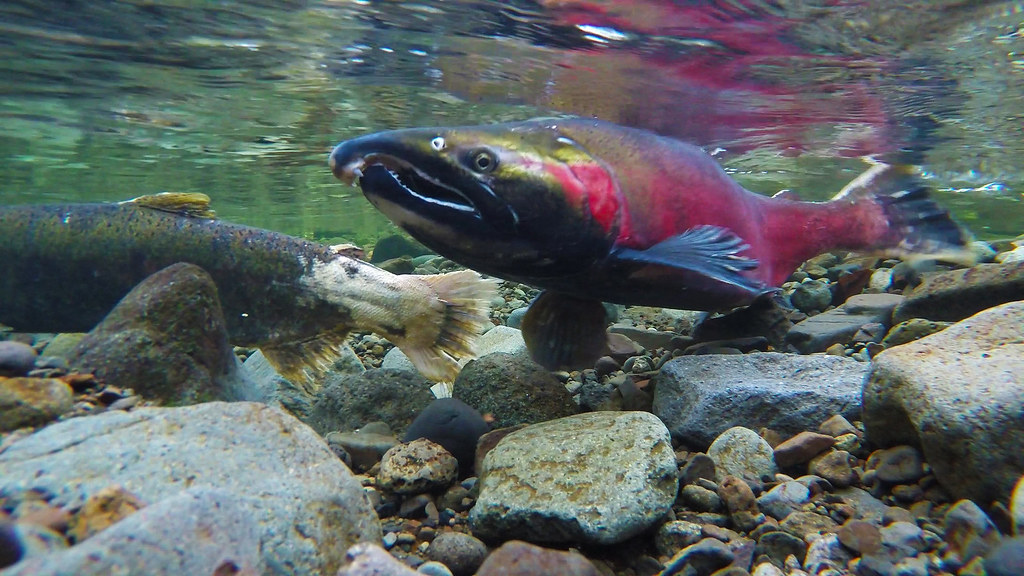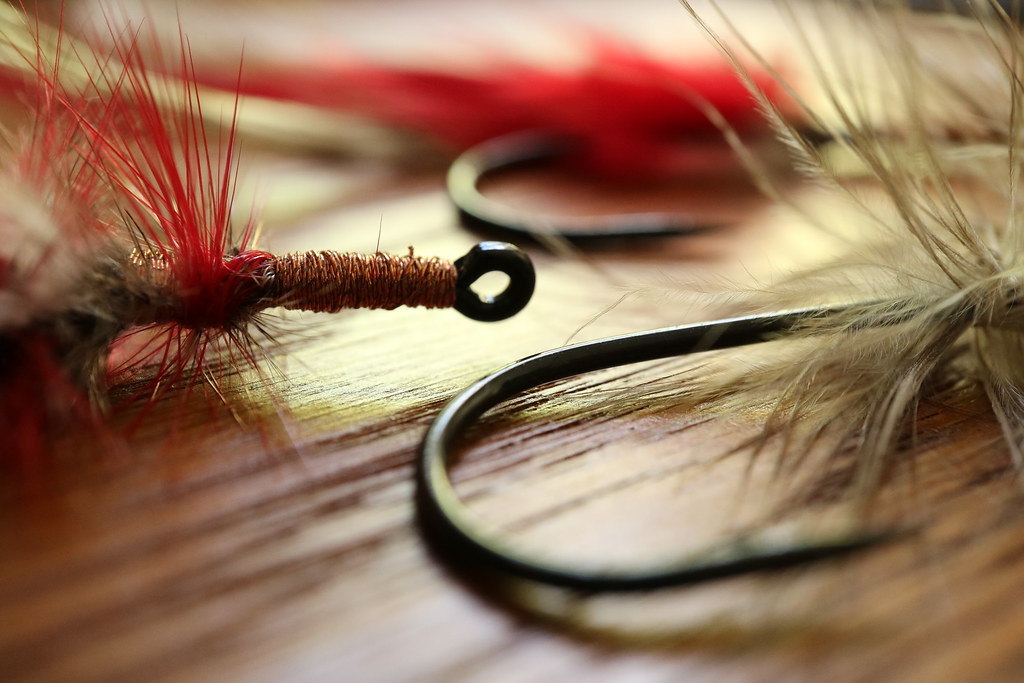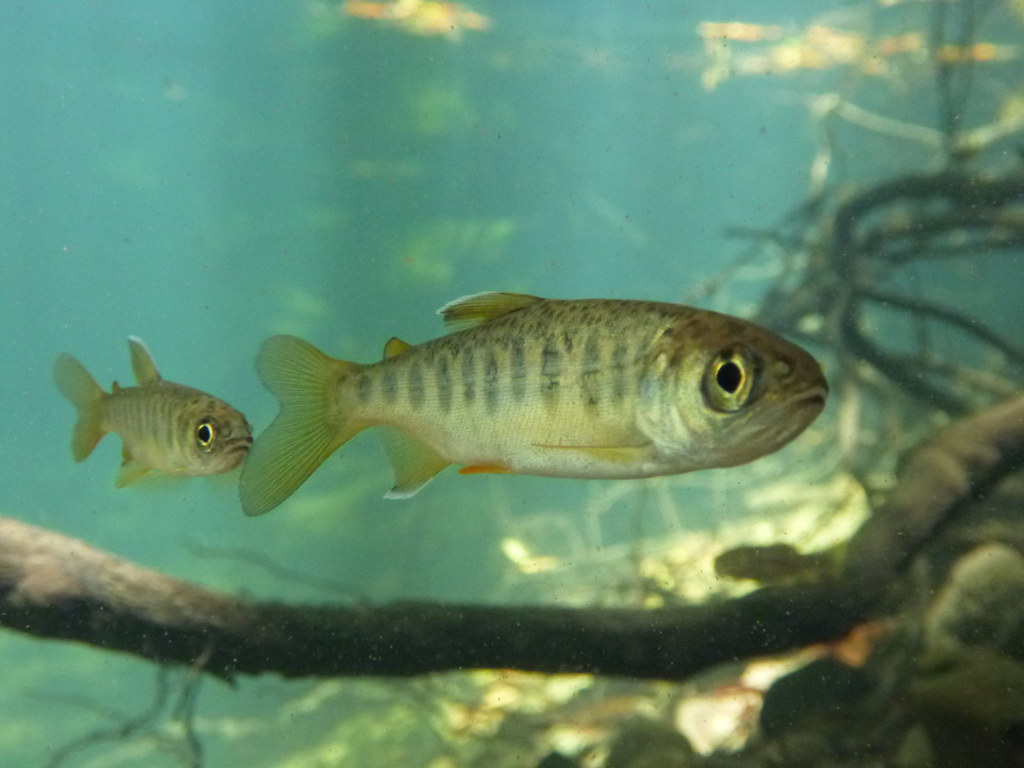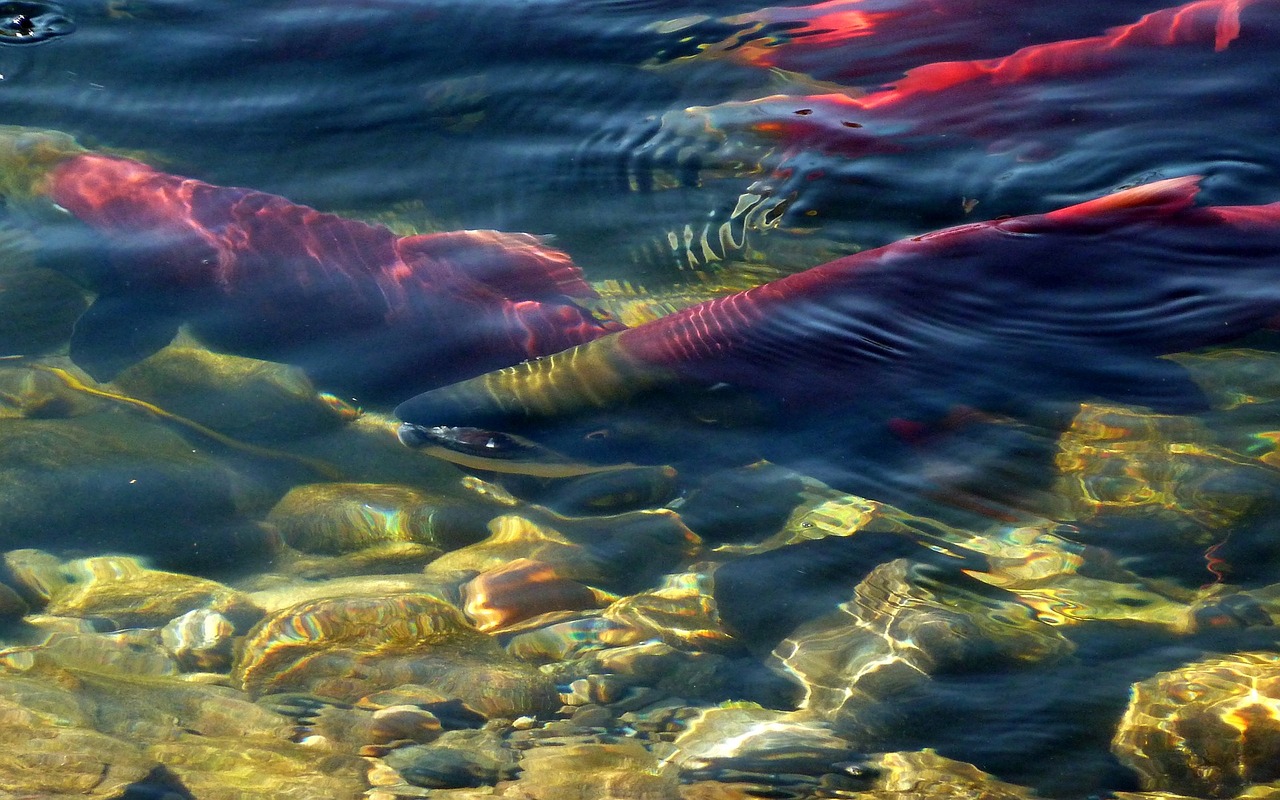Long known as The Salmon Capital of the World, Campbell River is a magical place to experience the yearly runs of five species of Salmon.
From fishing to snorkeling with salmon, and educational tours, the Campbell River area promises an unforgettable experience during the annual salmon runs.
When are Salmon in Campbell River?
Depending on the time of year, you’re virtually guaranteed an encounter with one or more species of salmon:
| Species | Run Time of Year |
|---|---|
| Chinook Salmon (aka King / Tyee) | Year Round (Tyees from July – Sept) |
| Coho Salmon | July – October |
| Pink Salmon | mid-July – September |
| Sockeye Salmon | mid-July – August |
| Chum Salmon | mid-Sept – November |
However, the sweet spot for Salmon in the Campbell River area is from August to November. Especially if you want to see them close-up in the rivers.
Here’s your comprehensive guide to salmon attractions in Campbell River area of Vancouver Island.
Table of Contents
Salmon Runs Where & When to See
Here are some places to see and experience the yearly salmon runs in Campbell River:
Quinsam River Hatchery
The Quinsam River near the Quinsam River Hatchery is a hotspot for viewing colossal numbers of salmon during their spawning season, from mid-July to November.
Venture 5 km west of downtown Campbell River to find this site brimming with salmon and local wildlife such as black bears and eagles.
The hatchery itself has an exceptional interpretive centre where you can learn about salmon life cycles and ecology.
Self-guided tours are available seven days a week from 8:00 am to 3:30 pm.
Best times to visit:
- Pinks: August – September
- Coho and Chinook: October – November
Snorkeling with Salmon
Snorkeling in the Campbell River provides an unparalleled viewpoint of the salmon run in our town’s namesake river.
From July to November, don your wetsuit, fins, mask, and snorkel to float down the river amidst thousands of salmon. If undertaking a self-guided tour, follow these steps:
- Start at the logging bridge on the Gold River Highway (ideal entry point).
- Float down the current, passing under two bridges.
- The water will get deeper and slower. Look for a brown lattice fence on the right side of the river. Your exit point is near the fence.
- Exit at the small beach at the end of Maple Street. (hopefully you have a car parked here or a friend to pick you up!)
Local outfitters offer rental gear for less than $50, or fully guided tours for around $100.

Oyster River Potholes
While most folks think of these potholes as a summer destination, it is a really neat place to check out when the salmon are running.
The reason: the water is very clear on the Oyster and the visibility is just amazing! It’s such a cool spot to see salmon close up.
Once a secret swimming hole to locals, it’s now on Google Maps. :/ If you are not a local, dig around the web & youtube for how to find the Oyster River Potholes.

Salmon Ladders on Vancouver Island
While watching bears fish for salmon on the Quinsam and snorkeling with salmon in the Campbell River are world-class experiences, there are a few spots that make good day trips from Campbell River to experience the salmon runs.
Nymph Falls Salmon Ladders
Nymph Falls is an amazing spot to visit, especially when the salmon are running and leaping upstream. In the 70s, fish ladders were carved into the falls to help these magnificent fish on their journey to spawn.
Location: Nymph Falls is just a 30 minute drive south from Campbell River.
Come by in October and November to witness the awe-inspiring sight of salmon making their incredible leaps up the falls.
It’s a sight you won’t want to miss!
Stamp River Park Salmon Run
In Port Alberni, Stamp River Park is a must-visit during salmon season. Watch as these remarkable fish gather at the base of Stamp Falls before tackling the fish ladders on their way to spawning beds.
Location: Stamp River Park is an almost 2 hour drive from Campbell River, but it really is worth the trip!
Thousands of Sockeye Salmon start their epic spawning runs up the Stamp River in late August, while Coho and Chinook join in from late September through early December. 📸
Salmon Education & Art
Can’t get enough salmon while you are on the island? Enhance your visit in Campbell River by exploring the rich cultural and historical significance of salmon at the Museum and the Maritime History Centre, which also serves as our Visitor Info Centre.
The Quinsam Hatchery’s visitor centre is another essential spot to learn about salmon. It has interactive exhibits that will impress adults and kids alike!
For unique art, check out “The River Nook” to see an amazing salmon mural & driftwood sculpture by local artist Alex Witcombe.
If you are looking for a day trip, The Quatse Salmon Stewardship Centre located in Port Hardy is dedicated to the world Salmon and is close to Bear Falls — another amazing salmon ladder.
Fishing for Salmon in Campbell River
Thinking about fishing for salmon in Campbell River? Here is a quick overview of where and when to fish. For more in-depth info, see the fishing calendar.

Saltwater Fishing
Fishing in the ocean, or tidal fishing, in Campbell River is a year-round opportunity. Most folks hire a fishing charter that take care of the boat, gear and have the knowledge to help you catch your limit.
Freshwater Fishing
For an equally thrilling experience, our freshwater rivers are filled with salmon making their monumental journey upstream to spawn. The Quinsam River and the centrally located Campbell River are prime spots teeming with Chinook, Coho, Chum, and Pink salmon.
With special fly-fishing zones, these rivers offer excellent opportunities whether you are a novice or an expert fly-fisher.
Remember to get your freshwater fishing license online before heading out. To purchase your freshwater fishing license visit this link.
Licensing and Regulations
A license is required for all anglers. There are separate licenses for freshwater and saltwater (also known as tidal) fishing.
If you are coming to Campbell River to go fishing you will need to purchase your license online, and print it off before heading out on your trip.
To learn more about licensing or to purchase your license online visit this link.
Be sure to check fishing regulations for Area 13 (salt water) or Region 1 (freshwater) before heading out!
FAQs about Salmon in Campbell River
Q: What types of salmon can you find in Campbell River?
A: Campbell River is home to five species of Pacific salmon: Chinook, Chum, Coho, Pink, and Sockeye.
Q: Do I need a license to fish in Campbell River?
A: Yes, a license is required for both freshwater and saltwater fishing. Licenses can be purchased online and must be printed out before your trip.
Q: What is the best time to visit Campbell River for salmon viewing?
A: The best times are from mid-July to November when salmon make their spawning run. Specific species have peak times, like Pinks in September and Coho and Chinook from October to November.
Q: Where can I go snorkeling with salmon?
A: The Campbell River is the prime spot for this activity, particularly starting from the logging bridge on the Gold River Highway and exiting at Maple Street.
Q: Can I view salmon at the Quinsam River Hatchery year-round?
A: Yes, the hatchery offers self-guided tours throughout the year, but the best times to view returning salmon are from late July to mid-November.
Q: What other wildlife can I expect to see during the salmon run?
A: Along with salmon, you’re likely to encounter black bears, eagles and herons especially near riverbanks where they feast on the fish.

Q: What is the life cycle of Salmon?
A: Here is a detailed overview of the life cycle of pacific salmon.
Egg Stage – Salmon begin their life as eggs deposited in gravel nests (redds) in freshwater streams and rivers. The female salmon digs the redd with her tail, lays the eggs, and then covers them with gravel. Eggs typically hatch during late winter or early spring.
Alevin Stage – Once hatched, the young salmon are called alevins. At this stage, they still carry a yolk sac which provides nourishment. They remain in the gravel until the yolk sac is absorbed.
Fry Stage – After the yolk sac is absorbed, the salmon emerge from the gravel as fry. They begin to feed on plankton and insects. Fry spend varying lengths of time in freshwater, depending on the species.
Parr Stage – As they grow, salmon develop parr marks, which are dark bars along their sides, aiding in camouflage. During this stage, they continue to grow and feed in freshwater environments.
Smolt Stage – As they prepare to migrate to the ocean, young salmon undergo physiological changes, a process called smoltification, which allows them to transition to saltwater environments.
Ocean Phase – Once in the ocean, salmon spend several years (depending on the species) growing and maturing. They travel vast distances in search of food and often migrate to the North Pacific Ocean.
Spawning Migration – Mature salmon eventually return to their natal rivers to spawn. This journey can be arduous, requiring them to navigate obstacles like dams and predators. They rely on their remarkable sense of smell to find their way back.
Spawning – Once they reach their spawning grounds, salmon undergo physical changes, developing vibrant colors. The female lays eggs in a redd, and males fertilize them. After spawning, most Pacific salmon die, contributing nutrients to the ecosystem.
Still have questions about seeing Salmon? Leave a comment below!
Ready your cameras, fishing gear, or snorkeling equipment and prepare for an adventure that merges the excitement of nature with the thrill of discovery. Campbell River awaits!
